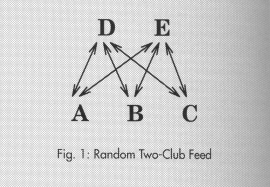|
Passing Fun
This
time I'll describe a very simple random pattern that nevertheless
Random
Two-Club Feed I
learned this straightforward but interesting pattern from Rick
Rubenstein, who attributes it to Baltimore juggler Bryan Olson. It has
two rows of jugglers facing each other. For the best effect, each row
should have about two or three jugglers in it (e.g., as in Fig. 1),
although other numbers of jugglers are possible.
Give
one juggler in each row three clubs. Everyone else gets only two. Thus
if there are N people, there are 2N+2 clubs in the pattern. It doesn't
matter which two people have the complete three clubs, as long as it
is one person in each row and they both start with the two clubs in
the same hand (say the right).
The
pattern works very simply. Whoever has a third club passes to someone
- anyone - on the opposite row on the next passing beat. Each juggler
with just two clubs doesn't juggle but waits until someone passes him
or her a third club.
For
starters, try this Random Two-Club Feed in a two-count or perhaps a
four count, whichever is more comfortable for your group. But of
course I recommend moving on to a three-count for balance after you're
familiar with the feel of the pattern. Maybe even try a one-count if
you've got a solid bunch of passers.
Actually,
the one-count shouldn't be all that hard, since you generally only
have to make one pass at a time - hence only one throw (no selves in a
one-count!). Whenever a club is coming to you, the hand to which it is
coming passes a club back to the other row. But a very important idea
to remember in this pattern, as well as in a normal six-club
onecount with two people, is to keep your passes high. They should
land at normal shoulder
No
matter what count you are passing on (hey, you can even try
pass-pass-self), since the pattern starts with only one extra club in
each row, and since on each beat
one club is passed from each row to the other, there is always exactly
one person in each row with three clubs. So although the passes can be
thrown randomly to the other row, no one ever ends up having to catch
two passes at the same
Theoretically,
then, the pattern could go on forever. After all, only two people are
juggling at a time, and they're only doing three clubs each, so what
could go wrong? Well, the first thing is that you have to pay
attention and watch carefully to keep track of who in the opposite row
has the extra club and thus might be passing to you. It's easy
to be distracted and follow a club that could have come to you but
didn't. After someone doesn't pass to you, you have to locate the next
club that might be passed to you - don't keep following the previous
extra club (which is now in your row!). Trying to follow the action
Something
you can try to avoid, but with
A
not uncommon mistake in this feed, especially if you're doing an odd
count (such as a three-count) is to throw to someone's wrong
In
any of these cases, correcting the situation is simple enough - you
just throw the next pass as another diagonal (at the right time). In
fact, either of the two passers on a given beat can correct this
situation. Of course, if both of them try to correct it (by passing a
diagonal), then it actually stays uncorrected. But in this situation,
there is about a 50-50 chance on every pass that it will be
successfully corrected, so it is generally fixed within a few passing
beats (provided a collision doesn't crop up first). On the other hand,
perhaps you don't even need to correct this situation! Its main
drawback is that two people may end up passing to each other's passing
hands at the same moment, making a collision
A
good number of people to do this random feed with is four or five.
With more than three people in a row the long diagonal throws from
comer to corner get a little harder to control (in time) and you may
find you get more collisions. But you could possibly try with up to
eight jugglers, four in each row. Of course, the more people in your
row, the less often you'll actually get to juggle, on the average.
Once you have the pattern under control, besides trying different counts, such as a threecount, you can do things like throw early or late doubles. Or you can add in trick throws like chops or flats easily enough. Have fun! |
